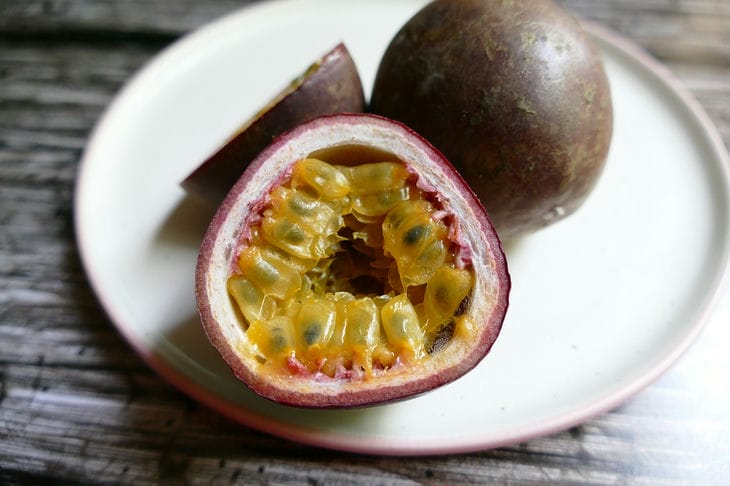Passion fruit is an exotic fruit that has become popular in recent years. Its sweet and sour taste and unusual appearance attract the attention of many people.
However, not everyone knows how to use it correctly and what it can be combined with.
Passion fruit is native to South America and gets its name from the Spanish word “maracuya,” meaning “pungent berry.” The fruit has a yellow-purple skin and juicy flesh with black seeds. Passion fruit is rich in vitamins A and C, calcium, and iron, making it a healthy choice.

Introduction to the World of Passion Fruit: History and Origins
Passion fruit is an exotic fruit that grows in the tropical regions of South America. Its name comes from the word "maracuya", which means "passion fruit" in the language of the Tupi Indians. The fruit was discovered by Europeans during the colonization of America and quickly gained popularity due to its unusual taste and unique properties.
Passion fruit is oval or round in shape, 5 to 10 cm in size. Its skin is thick and tough, and the pulp is juicy and sweet. Inside the fruit are many black seeds.
In the wild, passion fruit grows on vines and is commonly used to make drinks, desserts, and sauces. In some countries, this fruit is also used to treat various diseases due to its high antioxidant content.
Today, passion fruit can be found all over the world, especially in tropical countries. It can be eaten fresh, added to salads and desserts, or used to make sauces and drinks. With its unique flavor and variety of uses, passion fruit is becoming an increasingly popular fruit around the world.
Passion fruit taste and nutritional value
Passion fruit is a tropical fruit with a unique taste and aroma. Its sweet and sour pulp resembles a mixture of pineapple, tangerine and lemon. Passion fruit contains vitamins A, C, E, B1, B2, B3 and minerals - potassium, calcium, iron and phosphorus. In addition, this fruit has a high content of fiber and pectin substances.
Passion fruit can be eaten on its own or added to salads or desserts. It is used to make drinks or as an ingredient for sauces and jams. There is also a recipe for chicken with passion fruit - this dish turns out very juicy and aromatic.
Additionally, passion fruit is often used as a functional food to improve immunity and overall health due to its high antioxidant content.
Overall, it can be said that passion fruit is not only a very tasty but also a healthy fruit that is worth trying and adding to your diet.
Various ways to use passion fruit in cooking
Passion fruit is an exotic fruit that grows in tropical regions. It seems that passion fruit is difficult to use in cooking, but in fact, this fruit can be very useful and add an original taste to dishes.
One way to consume passion fruit is to make juices and drinks. The fruit has a bright sour taste and goes well with other ingredients such as honey, lime or mineral water.
Another way is to use passion fruit to make candies, jams or sauces. The pulp of the fruit contains a large amount of pectin, which helps create a jelly-like texture for desserts.
Passion fruit can also be used to decorate cakes or add freshness to salads. Some people prefer to eat the fruit as is, peeling off the skin and eating it like a pomegranate.
Overall, many exotic food lovers have appreciated the rapid growth of passion fruit in cooking. This fruit is a great addition to your diet, which will be a pleasant and healthy taste experience.
Medicinal properties of passion fruit and its use in the treatment of diseases
Passion fruit is an exotic fruit that originates from South America. It is rich in vitamins, minerals, and antioxidants, making it beneficial for health. Passion fruit contains a lot of calcium, iron, and phosphorus, which are necessary for maintaining healthy bones.
In addition, passion fruit also contains albumin, a plant-based protein with a high absorption rate by the body. Due to this property, passion fruit can be used in the treatment of various diseases.
For example, eating passion fruit can help with insomnia and anxiety due to its calming effect on the nervous system. Passion fruit is also great for headaches and arthritis due to its anti-inflammatory properties.
It can also be beneficial for people with diabetes due to its ability to control blood glucose levels. In addition, passion fruit is an excellent source of vitamin C, which supports the immune system and helps fight colds.
Overall, passion fruit is a healthy and tasty fruit that can be eaten on its own or added to smoothies, salads or baked goods.
How to Grow Passion Fruit at Home: Tips and Advice
Passion fruit is an exotic fruit that many gourmets love for its bright and unusual taste. However, it is not always possible to buy passion fruit in a regular store. Therefore, if you want to enjoy this fruit at any time of the year, you can try to grow it yourself.
First of all, it is worth clarifying that passion fruit is a liana plant. To grow it at home, you need to choose a suitable pot or container with support for the vine. The soil should be fertile and well-drained.
The plant needs sufficient light, so it should be placed on a south-facing window or illuminated with lamps.
An important aspect of growing passion fruit is maintaining the correct watering regime. The plant should be watered regularly and avoid drying out the soil.
It is also worth remembering that passion fruit has a high need for nutrients. Therefore, it is recommended to fertilize the plant once a month.
By following these tips, you can grow your own exotic fruit - passion fruit. Try adding it to cocktails or desserts and enjoy the unusual taste!
Previously, it was reported about preparing pilaf with pork .









